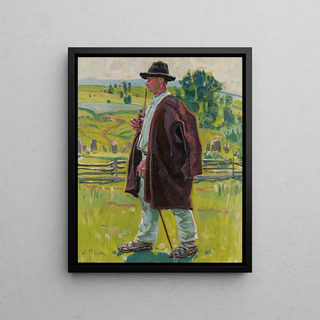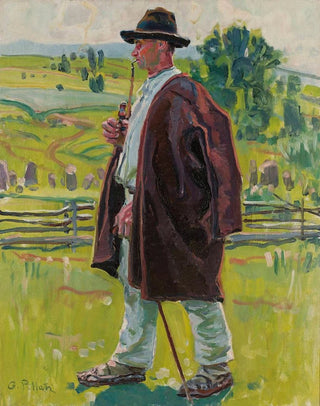Art print | Study of a Highlander - Gustav Pillati


View from behind

Frame (optional)
Gustav Pillati's "Study of a Highlander" is a true testament to the finesse and depth that characterize this painter's art. Through this piece, the artist invites us to immerse ourselves in a universe rich in emotion and tradition, where each brushstroke seems to tell a story. The depiction of a Highlander, an iconic figure of Scottish landscapes, evokes both strength and melancholy—a duality that runs through the artwork and captivates the viewer. This painting, far more than a simple illustration, is an exploration of cultural roots and identities, a reflection of the human soul set against a landscape that is both majestic and austere.
Style and uniqueness of the work
Gustav Pillati's style is marked by an impressive mastery of colors and textures. In "Study of a Highlander," earthy tones and shades of green blend harmoniously to create a landscape that is both realistic and poetic. The details of the traditional Highlander costume are rendered with remarkable precision, highlighting artisanal craftsmanship and the importance of dress traditions. The use of light in this piece enhances the atmosphere, playing with shadows and reflections to bring the scene to life. This ability to capture the essence of a moment, through refined pictorial technique, makes Pillati a fully-fledged artist, capable of transcending a simple portrait to create a true work of art.
The artist and his influence
Gustav Pillati, although less known than some of his contemporaries, managed to leave his mark on his era with his unique approach to painting. Influenced by the great masters of the past, he developed a style that is his own, blending realism and impressionism. His interest in folk themes and cultural traditions is reflected in his works, where he seeks to immortalize moments of daily life and symbols of identity. Pillati was a passionate defender of Scottish culture, and his work on the Highlander bears witness to this passion. Through his creations, he succeeded in raising awareness about the importance of preserving traditions, while r

Matte finish

View from behind

Frame (optional)
Gustav Pillati's "Study of a Highlander" is a true testament to the finesse and depth that characterize this painter's art. Through this piece, the artist invites us to immerse ourselves in a universe rich in emotion and tradition, where each brushstroke seems to tell a story. The depiction of a Highlander, an iconic figure of Scottish landscapes, evokes both strength and melancholy—a duality that runs through the artwork and captivates the viewer. This painting, far more than a simple illustration, is an exploration of cultural roots and identities, a reflection of the human soul set against a landscape that is both majestic and austere.
Style and uniqueness of the work
Gustav Pillati's style is marked by an impressive mastery of colors and textures. In "Study of a Highlander," earthy tones and shades of green blend harmoniously to create a landscape that is both realistic and poetic. The details of the traditional Highlander costume are rendered with remarkable precision, highlighting artisanal craftsmanship and the importance of dress traditions. The use of light in this piece enhances the atmosphere, playing with shadows and reflections to bring the scene to life. This ability to capture the essence of a moment, through refined pictorial technique, makes Pillati a fully-fledged artist, capable of transcending a simple portrait to create a true work of art.
The artist and his influence
Gustav Pillati, although less known than some of his contemporaries, managed to leave his mark on his era with his unique approach to painting. Influenced by the great masters of the past, he developed a style that is his own, blending realism and impressionism. His interest in folk themes and cultural traditions is reflected in his works, where he seeks to immortalize moments of daily life and symbols of identity. Pillati was a passionate defender of Scottish culture, and his work on the Highlander bears witness to this passion. Through his creations, he succeeded in raising awareness about the importance of preserving traditions, while r






